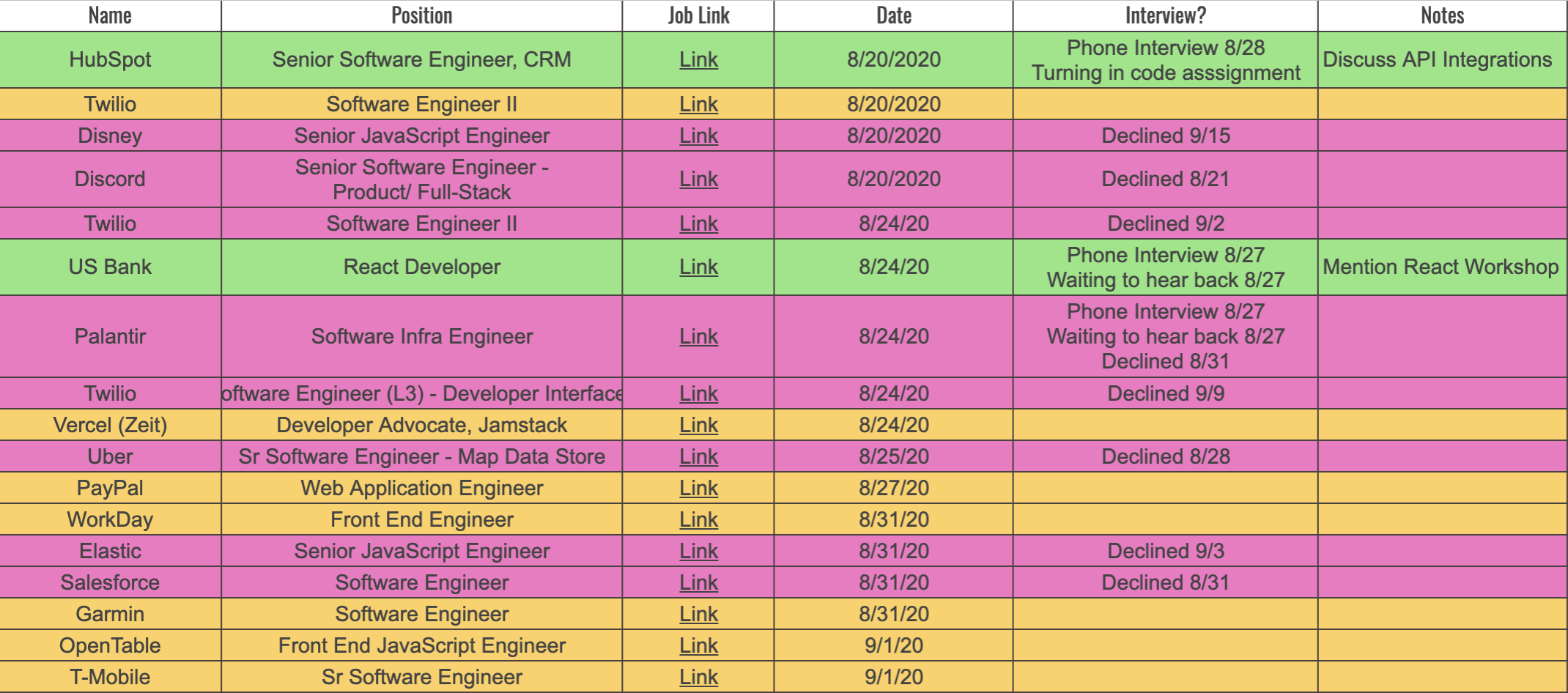Okay, so you have decided to start looking for a new job.
Admittedly, this is a process that people are not too fond of, generally speaking.
While I am pretty sure I can't convince you to thoroughly enjoy the job searching process, I can share a method I have used multiple times in my previous job searches that has made the process feel much more organized and productive.
It all starts with a spreadsheet.
Create a ledger of your progress
First, create a new spreadsheet and title it My Job Search Journey.
Next, I suggest you create six-column headers:
COMPANY NAME
A pretty obvious one, but this is a very important piece of information to capture.
No one wants to start an interview and completely space the name of the company they are interviewing for.
POSITION
If you are applying to multiple companies and positions, things can get jumbled up pretty easily.
There are so many different titles in the modern tech landscape.
You want to make sure that you remain mindful of each position you are applying to for now, so you can easily recall this prior to an interview at this company.
LINK TO JOB
Eventually, you are going to attract interest from a company you apply to, awesome!
At first, you are excited, and then suddenly a wave of anxiety falls over you.
You do not recall applying for this position and are completely spacing the pertinent details for the role.
This is why inserting a direct link to the job posting is a prudent move.
Not only does this allow you to quickly recall important details of the company and its mission, but it also gives you great references for talking points during your interview with them.
These references can range from company ethos that you can speak to from personal experience or technology they use that you have also worked with.
DATE APPLIED
At first, this data point might not seem too relevant. But I think it can serve (at least) two purposes.
- First, it helps serve as a metric of how many applications you have submitted in a day, week, or month
This can give you a huge confidence boost, especially on days when you feel that the job search is never-ending. With date data captured, you can look back and reflect on all of the hard work you have put into the search, even before you get interviews.
That alone is hard work and you should be proud of that!
- Second, it can offer insight into how long a standard interview process can take
In my post How to Prepare for a Software Developer Interview, I explain the steps of the interview process.
This process can vary depending on the position and company. But being able to look back at an initial date and figure out where you currently are with a particular company can be another rewarding metric.
The interview process can be long and taxing. But as each day moves past your initial application date you can use this metric to give yourself another internal confidence boost. Wherever you are today is farther than where you were yesterday.
Be proud of that!
APPLICATION STATUS
After several applications paired with several interviews all at different stages, things can get really difficult to keep track of in between the ears.
This is where the Application Status column can really help.
If a company reaches out to you to schedule an interview, start keeping track of the date, time, and type of interview at each step along the way.
This can help keep awareness high for your immediate priorities, as well as a good way to avoid double-booking interviews for yourself.
I also suggest keeping track of applications that you were rejected from in this column.
By keeping track of your successes as well as your failures in the job search, you make it easier to examine your success rate.
If you find that out of one hundred companies, you are only getting five replies, it might be time to examine the things you have control over (like your resume and, if you have one, your cover letter).
All-in-all, having these data points really helps you solidify why you are or are not getting the results you want in your job search.
NOTES
Even if you are applying to jobs full-time, it can be really difficult to keep straight all the details of each job you have an interest in.
The last column, Notes, is essentially a placeholder for miscellaneous thoughts that you have about the company, position, or interview process.
This is also a great place to write reminders for whichever step of the interview you are in.
For example – Company ethos: Think of the end-user at all costs. Mention user acceptance meeting experience!
If you spend a little bit of time to jot down a few notes that you think would be helpful during an interview process for a company, they usually go a long way for you and help you stand out more as a candidate.
The more thorough your preparation and the more thoughtful questions or experiences you discuss, the more favorable you'll appear to the interviewer. And it shows that you have a genuine interest in the position/company.
The Final Product

Next step: crush the interview!
If you have spent time on the job search and tracked your journey, I can not promise you that you will get an interview at each company you apply for. But I can promise you will feel more prepared and organized at each step along the way.
If you have put in the time and landed interviews, congrats! I wish you all the best on your journey.
If you are just beginning the job search process, good luck! You've got this.
Are you new to software development and trying to land an interview? Take a look at my post on Getting an Interview as a Software Developer.

